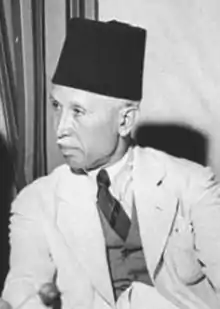Nasuhi al-Bukhari
Nasuhi al-Bukhari (Arabic: نصوحي البخاري) or Nasuh al-Boukhari (Arabic: نصوح البخاري; 1881 – 1 July 1961) was a Syrian soldier and politician who briefly served as Prime Minister of Syria in 1939.
Nasuhi al-Bukhari | |
|---|---|
نصوحي البخاري | |
 Nasuhi al-Bukhari in 1943 | |
| 12th Prime Minister of Syria | |
| In office 5 April 1939 – 8 July 1939 | |
| President | Hashim al-Atassi |
| Preceded by | Lutfi al-Haffar |
| Succeeded by | Khalid al-Azm |
| Minister of Defence of Syria | |
| In office 5 April 1939 – 8 July 1939 | |
| President | Hashim al-Atassi |
| Preceded by | Mazhar Raslan |
| Succeeded by | Abd al-Ghaffar al-Atrash |
| Personal details | |
| Born | 1881 Damascus, Ottoman Syria |
| Died | 1 July 1961 (aged 79–80) Damascus, United Arab Republic |
| Alma mater | Ottoman Military Academy |
| Military service | |
| Allegiance |
|
| Rank | Colonel |
Career
Early career
Nasuhi al-Bukhari received his education at the Ottoman Military Academy in Istanbul. He served in the Ottoman Army until he was captured by the Allies during World War I. In 1916, after escaping his Siberian exile, he went back to Istanbul.[1]
When the Ottoman Empire fell in 1918, Faisal I declared himself King of Syria. Under Faisal, Bukhari commanded the Aleppo garrison before being sent to Cairo in January 1920 as military attache to Egypt. In July 1920 French Mandate of Syria was declared,[1] and the country was divided into several independent states. In September 1920, Haqqi al-Azm was appointed governor of the State of Damascus,[2] and in December he appointed Bukhari as minister of military affairs in his administration, which served until 1922.[1] After the suppression of the Great Syrian Revolt in 1926, Ahmad Nami was appointed by the new French Commissioner, Henri de Jouvenel, to head a provisional council of ministers in the State of Syria, which comprised the former states of Damascus and Aleppo.[3] Bukhari served as minister of agriculture in Ahmad Nami's cabinet[1] until its resignation in February 1928.[4]
Premiership
On 5 April 1939, during a cabinet crisis between the ruling National Bloc and the opposition,[5] nationalist leader Hashim al-Atassi called on Bukhari to form a non-party government.[6] In addition to being premier, Bukhari held the portfolios of interior and defense, and appointed independent veteran politician, Khalid al-Azm, minister of economy. Bukhari had responsibility for talks to ratify the Franco-Syrian Treaty of Independence of 1936, but these broke down when the French retreated from the terms of the treaty, and demanded to keep several military bases in the country.[1] He subsequently resigned on 8 July 1939.[1]
Later life
Between August 1943 and November 1944 Bukhari was minister of education and acting minister of defence in Saadallah al-Jabiri's cabinet. However, his subsequent advocacy of a Syrian Army with military draft proved electorally unpopular in Damascus.[1] After losing his parliamentary seat in the 1947 elections, he retired from political life.[7]
References
Citations
- Moubayed, 2006, p. 216
- Tauber, 1994, p. 38.
- Lenczowski, 1980, p. 317.
- Fisher, 1971, p. 415.
- Moubayed, 1999, p. 130
- Mardam Bey, 1994, p. 17.
- Moubayed, 2006, p. 217
Bibliography
- Moubayed, Sami M. (2006). Steel & Silk: Men and Women who Shaped Syria 1900–2000. Cune Press. ISBN 978-1-885942-41-8. Retrieved 11 September 2012.
- Tauber, Eliezer (1994). The Formation of Modern Iraq and Syria. Routledge. ISBN 9780714645575. Archived from the original on 7 April 2022. Retrieved 22 September 2012.
- Lenczowski, George (1980). The Middle East in World Affairs. Cornell University Press. ISBN 9780801412738. Retrieved 22 September 2012.
French guidance. At the same 1926.
- Fisher, Sydney Nettleton (1971). The Middle East: A History. Routledge and K. Paul. ISBN 9780710072108. Archived from the original on 12 January 2023. Retrieved 22 September 2012.
- Moubayed, Sami M. (1999). The politics of Damascus, 1920–1946. Tlasse House. Archived from the original on 12 January 2023. Retrieved 22 September 2012.
- Mardam Bey, Salma (1994). Syria's quest for independence. Ithaca Press. ISBN 978-0-86372-175-5. Retrieved 11 September 2012.
External links
- Nasuh al-Boukhari at syrianhistory.com
